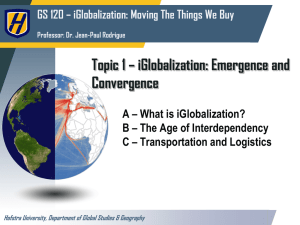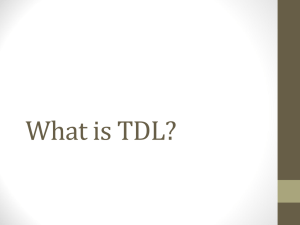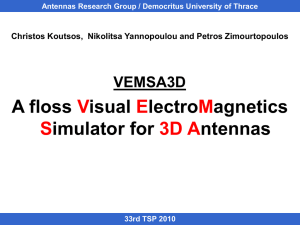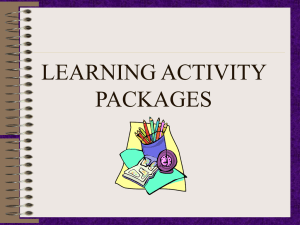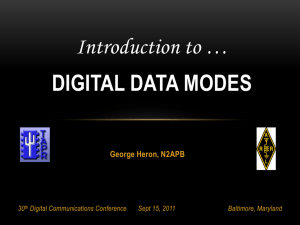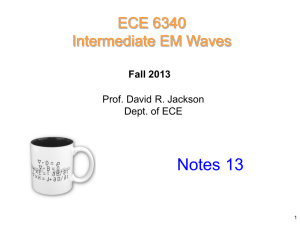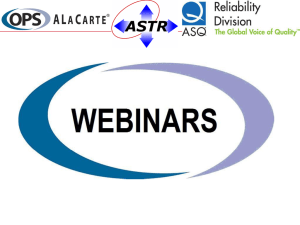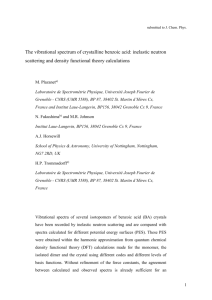LAND TRANSPORTATION ENGINEERING (Notes for Guidance )
advertisement
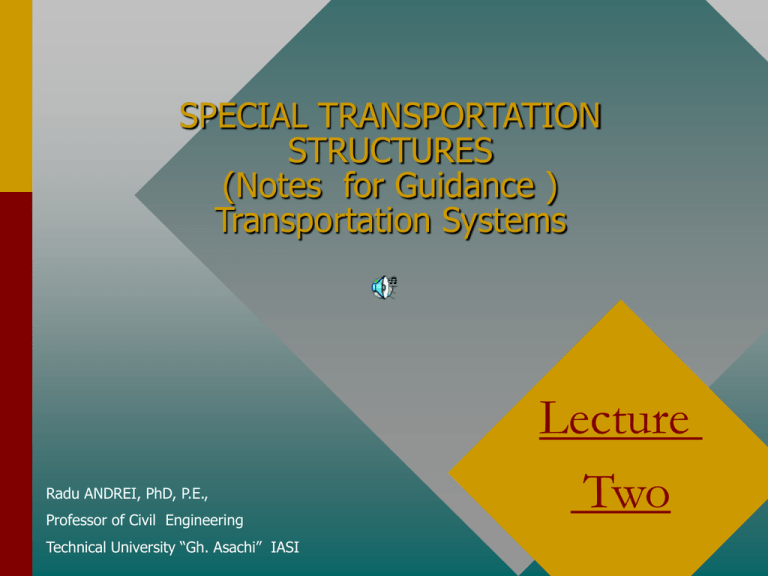
SPECIAL TRANSPORTATION STRUCTURES (Notes for Guidance ) Transportation Systems Radu ANDREI, PhD, P.E., Professor of Civil Engineering Technical University “Gh. Asachi” IASI Lecture Two Transportation Systems Developing a transportation system Modes of transportation & organizations Problems Additional Readings Developing a transportation system(1) Definition of a transportation system • The transportation system in a developed nation is an aggregation of vehicles, guideways,terminal facilities and control systems that move freight and passengers. • The transportation system involves a network of modes that have evolved over many years. The transportation systems that have evolved have produced a variety of modes that complement each other . Thus intercity travel involves auto and air modes; intercity freight travel involves pipeline, water, rail and trucking; urban passenger travel involves auto or public transit Developing a Transportation System(2) Main components of a transportation mode • The main components of any of these various modes of transportation are : the fixed plant( the infrastructure network)/the rolling stock( the park of specific vehicles)/ the management scheme (these systems are permanently planned, designed, built, operated and maintained by specific organizations and agencies). New techniques are being applied for operating and maintaining these systems , safely and economically. • The system consists of vehicles , guideways, terminl facilities, and control systems, all these operating according established procedures and schedules in the air, on land, and on water. The system also requires harmonious interaction with the user, the operator and the environment. Developing a Transportation System (3) Advantages and complementarity of various transportation modes • .Each mode of transport has inherent advantages of cost, travel time, convenience and flexibility that makes it “ right for the job” under the certain set of circumstances. • The automobile is considered a reliable,comfortable and flexible form of personal transportation for many people. • Air transportation , supplemented by the auto for local travel will be selected when distances are great and time travel is at a premium • Trucks have the advantage of mobility and flexibility and the ability to provide door-to-door services Developing a Transportation System (4) Advantages and complementarity of various transportation modes • Waterways can ship heavy commodities at low costs, but at low speeds and only between on a river or a canal. • Railroads can hole an imense variety of commodities at low cost between any two points but usually require truck transportation to deliver the goods to a freight terminal or to their final destination. • Rail shipments , usually are made once or twice a week in big lots, whereas truck shipments are made in smaller amounts and on a daily basis , depending on demand. Even the lower rail freight rates do not compete with track flexibility, a trend to combining the capabilities of both modes is now arisen toward intermodalism. Developing a Transportation System (5) Interaction of supply and demand of transport • The transportation system that exist at any point in time is the result of the interaction of two main factors : • (a) the demand of transport which depends from the state of the economy. • (b) the extent and quality of the system expressed in its capacity to supply transportation facilities and services. • Thus in periods of periodical unemployment or rising of fuel costs, the demand for transportation tends to decrease. However if if a new and significantly cheaper transportation mode is introduced, the demand for the new mode will increase , decreasing demands for the existing old modes. Developing a Transportation System (6) Interaction of supply and demand of transport(continuing) • If for particular situation of a transport facility( for example the study of supply and demand for a tooled bridge), we consider two curves, one of describing the demand for transportation at a particular point in time and the other describing how available transportation service or supply is affected by the volume of traffic that uses the system, we can use these curves to determine the volume of traffic which can be expected to use the respective transport facility . • This point will be found where the demand curve intersects the the supply curve , because any other value, different from this point will create un undesired schift in demand, either upward or downward, until the echilibrium point is reached. If the volume incresed beyond the equilibrium point, cost would go up and demand will drop. Likewise, if the volume dropped below the equilibrium point, cost would go down and demand will increase. Thus in both instances we are approaching the equilibrium Developing a Transportation System (6) Interaction of supply and demand of transport(continuing) • At any point, the nation’s transportation system is in a state of equilibrium as expressed by the traffic carried for each mode and the levels of service provided, expressed in terms of time, cost, frequency and comfort. • This equilibrium is the result of the f permanent evolution and interaction of the following factors : • market forces such as state of economy, competition, costs and prices for services , • government actions ( regulation, subsidy, promotion) • and transport technology ( speed, capacity,range, reliability) Modes of Transportation (1) General considerations • Conceived as a complex network of modes and facilities that furnishes shippers and travelers with a wide range of choices in terms of service provided, the transportation system of a country or of the region or of a city has to be highly developed. • Each mode of transportation has to offer a unique set of service characteristics in terms of travel time, frequency, comfort , reliability, convenience and safety. To describe the relative values of these attributes the term level of service is currently used. • In order to make the tradeoffs and to select the appropriate mode of transport thye , the traveler or the shipper must compare the level of service offered with the cost. Modes of Transportation (2) Freight and passenger traffic • The principal modes of intercity freight transportation are highways, railways water and pipeline . Traffic carried by each of these modes have varied considerably in the last fifty years . • The four principal carriers for freight movement (rail, truck,pipeline and water ) account for between 15 to 40 percent of the total, the air freight, which is an important carrier for high-value goods is insignificant, representing usually less the half percent from the total. • The distribution of passenger transportation is much different from that of freight, one mode such as that of the automobile accounts between 65 to 80 percent of all domestic intercity passenger -kilometers traveled. The remaining modes - air, bus and rail share a market representing 20 to 35 percent. Modes of Transportation (3) Public transportation • Public transportation is a generic term used to describe any and all of the familly of transit services available to urban and rural residents. • The public transportation system must provide high -capacity, energy -efficient movement in densely traveled corridors. Also it must provide efficent options in medium or lowdensity areas for the auto owners who do not wish to drive and an essential service to those without access to an automobile - school children,senior citizens, and others who may be economically or physically disadvantaged. Modes of Transportation (4) Public transportation key-factors • According a study , undertaken in 1990 ,by the American Association of State Highway and Transportation Officials (AASHTO) in US, in consolidating the role of the public transportation the following six key factors has been identified: • funding alternatives with the aim of obtaining funds from a wide range of public and private sources; • management alternatives aimed to provide an acceptable level of service at a resonable cost; • development of public -private sector seen as an innovative approach to develop a healthier transport industry; Modes of Transportation (5) Public transportation key-factors ( continuing) • political cooperation and support seen s essential if public transportation is to carry out its mission in an effective manner, the commitment of a governor or of maire to public transportation being a vital element for success • technological advances in bus, rail, and ferry modes , consisting in advances in vehicle design, developmet and implementation of electric cars and other ecological vehicles, are expected Modes of Transportation (6) Public transportation key-factors ( continuing) • insustry involvment in public transportation is expected to be implemented through the cooperation of several national organiazations , which collectivelly can help influence key areeas of concern , including funding, cost-effectiveness and productivity, pubic-private cooperation, coordination, community relations and urban planning and development. These organiazations may include The Ministry of transport and public works, The Transportors Union, The National Aministration, of Roads,etc, • In USA such organiazations include the American Public Transit association (APTA) the Amerivan Association of State ighway and Transportation officials -AASHTO, the Federal Transit Administration (FTA) and the Federal Highway Administration (FHWA) Modes of Transportation (7) Highway transportation Problems (1) • To illustrate the importance of transportation in our life, make a comparison of how your typical day might be changed with or without one mode of transportation. Consider your personal transportation as well as goods and services that you relay on. • Review the classified section of the telephone directory of your city and identify the main transportation agency and organizations located in your town. Problems (2) • A bridge have been constructed over the river Siret. The total cost excluding tools to travel across the bridge is expressed as C= 10+ 0.5V, where Vis the the number of vehicles per hour and C is the cost /vehicle in cents. The demand for for travel across the bridge is V= 3000-10C • Notes: • 1.The amount of traffic will depend on cost • 2.The cost to cross the bridge will depend on the bridge toll and the travel time for cars and trucks. If only a few vehicles cross, little time is lost waiting at the tollbooth or in congested traffic. However as more and more trucks are using the bridge the time required to cross will increase, waiting lines will be formed along the tollbooth and also may appear traffic congestion on the other end. Problems (3) • In the conditions described for the bridge in the previous slide perform the following: – determine the volume of traffic across the bridge (483veh/day) – if a tool of 25 cents is added what will be the volume of traffic across the bridge ? (511 veh./day) – an additional tollbooth is added, thus changing the travel time across the bridge, and the new cost function becomes: C=10+0.3V. Determine the volume of traffic which will cross the bridge in these new conditions ( 725 veh/day) – determine the tool to yield the highest revenue for demand and and supply function for initial condition (…) Problems (2) • Keep a diary of all trips you make for a period of one week, recording the the purpose of each trip, how you traveled, the approximate distance traveled , and the trip time. From this estimate the proportion of your monthly budget is spent for transportation and try to extrapolate these data to the tripmaking characteristics for all students of your group • Most departments or agencies for transportation incorporate at least five major transportation engineering subspecialties within their organizations. List and indicate at least three tasks falling under each subspecialty. Problems (3) • In the hypothesis that a country has a population of 23 million people and a average ownership of 0,5 cars per person, each driven an average of 10,000 Km per year, at 100Km per 7 liter of gasoline. Officials estimate that an additional EUR 75 million per year in revenue will be necessary to improve the highway system and they proposed an increase in the gasoline tax, to meet this need. Determine the required in cents per liter. • List at least three major detrimental effects that are directly related to the construction and use of our highway transportation system. Do the same exercise for our rail transportation system. Problems (4) • For the city of Iasi, describe briefly the actual transportation system, including its transportation modes. Try to formulate your own opinion about how this transportation system meet the needs and expectations of the citizens of Iasi. Which improvements or corrections are necessary to by applied ? • Estimate the number of motor vehicles in the city of Iasi, and the total number of km driven each year. What is the total revenue raised for each 1cent/ liter tax? Assume that the average vehicle achieves 36 Km per 3.785 liter of gasoline. Additional Readings • Andrei R. Land Transportation Engineering, Technical Publishers, Chisinau, 2002 • Garber j.N., Hoel A.,L, Traffic and Highway Engineering, revised second edition, PWS Publishing,1999 • American Highways • www.trb.org/trb newsletter • www.andnet.ro
